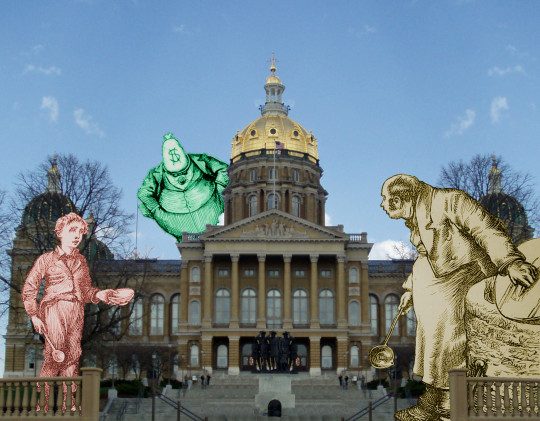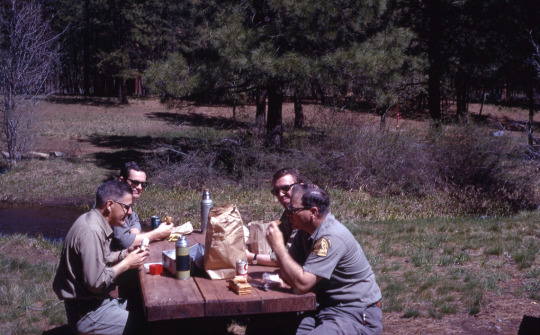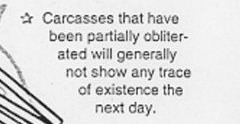#USDA
Text
Iowa's starvation strategy

I don’t really buy that “the cruelty is the point.” I’m a materialist. Money talks, bullshit walks. When billionaires fund unimaginably cruel policies, I think the cruelty is a tactic, a way to get the turkeys to vote for Christmas. After all, policies that grow the fortune of the 1% at the expense of the rest of us have a natural 99% disapproval rating.
If you’d like an essay-formatted version of this post to read or share, here’s a link to it on pluralistic.net, my surveillance-free, ad-free, tracker-free blog:
https://pluralistic.net/2023/04/19/whats-wrong-with-iowa/#replicable-cruelty
So when some monstrous new law or policy comes down the pike, it’s best understood as a way of getting frightened, angry — and often hateful — people to vote for policies that will actively harm them, by claiming that they will harm others — brown and Black people, women, queers, and the “undeserving” poor.
Pro-oligarch policies don’t win democratic support — but policies that inflict harm a ginned-up group of enemies might. Oligarchs need frightened, hateful people to vote for policies that will secure and expand the power of the rich. Cruelty is the tactic. Power is the strategy. The point isn’t cruelty, it’s power:
https://pluralistic.net/2022/06/25/roe-v-wade-v-abortion/#no-i-in-uterus
But that doesn’t change the fact that the policies are cruel indeed. Take Iowa, whose billionaire-backed far-right legislature is on a tear, a killing spree that includes active collaboration with rapists, through a law that denies abortion care to survivors of rape and forces them to bear and care for their rapists’ babies:
https://www.nytimes.com/2023/03/16/us/politics/iowa-kamala-harris-abortion.html
The forced birth movement is part of the wider far-right tactic of standing up for imaginary children (e.g. “the unborn,” fictional victims of Hollywood pedo cabals), and utterly abandons real children: poor kids who can’t afford school lunches, kids in cages, kids victimized by youth pastors, kids forced into child labor, etc.
So Iowa isn’t just a forced birth state, it’s a state where children are now to be starved, literally. The state legislature has just authorized an $18m project to kick people off of SNAP (aka food stamps). 270,000 people in Iowa rely on SNAP: elderly people, disabled people, and parents who can’t feed their kids.
Writing in the Washington Post, Kyle Swenson profiles some of these Iowans, like an elderly woman who visited Lisa Spitler’s food pantry for help and said that state officials had told her that she was only eligible for $23/month in assistance:
https://www.washingtonpost.com/dc-md-va/2023/04/16/iowa-snap-restrictions-food-stamps/
That’s because Iowa governor KimReynolds signed a bill cutting the additional SNAP aid — federally funded, and free to the state taxpayers of Iowa — that had been made available during the lockdown. Since then, food pantries have been left to paper over the cracks in the system, as Iowans begin to starve.
Before the pandemic, Spitler’s food pantry saw 30 new families a month. Now it’s 100 — and growing. Many of these families have been kicked off of SNAP because they failed to complete useless and confusing paperwork, or did so but missed the short deadlines now imposed by the state. For example, people with permanent disabilities and elderly people who no longer work must continuously file new paperwork confirming that their income hasn’t changed. Their income never changes.
SNAP recipients often work, borrow from relations, and visit food pantries, and still can’t make ends meet, like Amy Cunningham, a 31 year old mother of four in Charlton. She works at a Subway, has tapped her relatives for all they can afford, and relies on her $594/month in SNAP to keep her kids from going hungry. She missed her notice of an annual review and was kicked off the program. Getting kicked off took an instant. Getting reinstated took a starving eternity.
Iowa has a budget surplus of $1.91B. This doesn’t stop ghouls like Iowa House speaker Pat Grassley (a born-rich nepobaby whose grandpa is Senator Chuck Grassley) from claiming that the cuts were a necessity: “[SNAP is] growing within the budget, and are putting pressure on us being able to fund other priorities.”
Grassley’s caucus passed legislation on Jan 30 to kick people off of SNAP if their combined assets, including their work vehicle, total to more than $15,000. SNAP recipients will be subject to invasive means-testing and verification, which will raise the cost of administering SNAP from $2.2m to $18m. Anyone who gets flagged by the system has 10 days to respond or they’ll be kicked off of SNAP.
The state GOP justifies this by claiming that SNAP has an “error rate” of 11.81%. But that “error rate” includes people who were kicked off SNAP erroneously, a circumstance that is much more common than fraud, which is almost nonexistent in SNAP programs. Iowa’s error rate is in line with the national average.
Iowa’s pro-starvation law was authored by a conservative dark-money “think tank” based in Florida: the Opportunity Solutions Project, the lobbying arm of Foundation For Government Accountability, run by Tarren Bragdon, a Maine politician with a knack for getting money from the Koch Network and the DeVos family for projects that punish, humiliate and kill marginalized people. The Iowa bill mirrors provisions passed in Kentucky, Kansas, Wisconsin and elsewhere — and goes beyond them.
The law was wildly unpopular, but it passed anyway. It’s part of the GOP’s push for massive increases in government spending and bureaucracy — but only when those increases go to punishing poor people, policing poor people, jailing poor people, and spying on poor people. It’s truly amazing that the “party of small government” would increase bureaucratic spending to administer SNAP by 800% — and do it with a straight face.
In his essay “The Utopia of Rules,” David Graeber (Rest in Power) described this pathology: just a couple decades ago, the right told us that our biggest threat was Soviet expansion, which would end the “American way of life” and replace it with a dismal world where you spent endless hours filling in pointless forms, endured hunger and substandard housing, and shopped at identical stores that all carried the same goods:
https://memex.craphound.com/2015/02/02/david-graebers-the-utopia-of-rules-on-technology-stupidity-and-the-secret-joys-of-bureaucracy/
A society that can’t feed, house and educate its residents is a failed state. America’s inability to do politics without giving corporations a fat and undeserved share is immiserating an ever-larger share of its people. Federally, SNAP is under huge stress, thanks to the “public-private partnership” at the root of a badly needed “digital overhaul” of the program.
Writing for The American Prospect, Luke Goldstein describes how the USDA changed SNAP rules to let people pay with SNAP for groceries ordered online, as a way to deal with the growing problem of food deserts in poor and rural communities:
https://prospect.org/health/2023-04-19-retail-surveils-food-stamp-users/
It’s a good idea — in theory. But it was sabotaged from the start: first, the proposed rule was altered to ban paying for delivery costs with SNAP, meaning that anyone who ordered food online would have to use scarce cash reserves to pay delivery fees. Then, the USDA declined to negotiate discounts on behalf of the 40 million SNAP users. Finally, the SNAP ecommerce rules don’t include any privacy protections, which will be a bonanza for shadowy data-brokers, who’ll mine SNAP recipients’ data to create marketing lists for scammers, predatory lenders, and other bottom-feeder:
https://www.democraticmedia.org/sites/default/files/field/public-files/2020/cdd_snap_report_ff.pdf
The GOP’s best weapon in this war is statistical illiteracy. While racist, sexist and queerphobic policies mean that marginalized people are more likely than white people to be poor, America’s large population of white people — including elderly white people who are the immovable core of the GOP base — means that policies that target poor people inevitably inflict vast harms on the GOP’s most devoted followers.
Getting these turkeys to vote for Christmas is a sound investment for the ultra-rich, who claim a larger share of the American pie every year. The rich may or may not be racist, or sexist, or queerphobic — some of them surely are — but the reason they pour money into campaigns to stoke divisions among working people isn’t because they get off on hatred. The hatred is a tactic. The cruelty is a tactic. The strategic goal is wealth and power.
Tomorrow (Apr 21), I’m speaking in Chicago at the Stigler Center’s Antitrust and Competition Conference. This weekend (Apr 22/23), I’m at the LA Times Festival of Books.
[Image ID: The Iowa state-house. On the right side of the steps is an engraved drawing of Oliver Twist, holding out his porridge bowl. On the left side is the cook, denying him an extra portion. Peeking out from behind the dome is a business-man in a suit with a dollar-sign-emblazoned money-bag for a head.]
Image:
Iqkotze (modified)
https://commons.wikimedia.org/wiki/File:Iowa_State_Capitol_April_2010.jpg
CC BY 3.0
https://creativecommons.org/licenses/by-sa/3.0/deed.en
#pluralistic#ecommerce#Foundation for Government Accountability#fga#iowa#florida#ebt#david graeber#utopia of rules#big government#usda#surveillance#cruelty#gop#devos#starvation#food stamps#snap#koch network#Tarren Bragdon#state policy network
573 notes
·
View notes
Text

USDA Forest Rangers stop for lunch.
Oregon
1969
#vintage camping#campfire light#oregon#usda#forest rangers#forest service#history#outdoors#camping#1960s
313 notes
·
View notes
Text
Speaking in very general terms just from what I see, more people like chicken/birds than like fish meat, and more people like beef/pork than birds. As fish are farthest from us evolutionarily, next being birds, and then mammals, one could come to the conclusion that the closer a species is to us the more delicious their meat is. Therefore, it stands to reason that actually cannibali--(i am taken down by a sniper hired by the FDA and USDA working in conjunction)
87 notes
·
View notes
Text

Food comes first. U.S. Department of Agriculture - 1944.
#vintage advertising#vintage illustration#ww2#wwii#life during wartime#the home front#farming#u.s. department of agriculture#usda#farmers#world war ii#vintage posters#propaganda posters
60 notes
·
View notes
Video
Black Farmers
the 1619 podcast has a great episode about Black Farmers
https://www.nytimes.com/2019/10/04/podcasts/1619-slavery-sugar-farm-land.html?
In the fall of 1864 at the height of the Civil War, one of the most famous Union generals, William Tecumseh Sherman, begins his march out of the city of Atlanta to the sea.
And as Sherman and his men make their way through Georgia, black Southerners are seeing an opportunity.
And so by the thousands, they start to leave the plantations where they’ve been enslaved and are falling behind Sherman’s troops as they make their way to the coast.
But these newly liberated people were not exactly welcomed. Sherman didn’t actually oppose slavery, and so he’s really not that sympathetic to those who are fleeing these plantations, and he also sees them as a drain on his resources. They are families. They are people of all ages, young and old, who need food and care, and they are slowing the troops down.
By December of that year, some of Sherman’s troops are about to approach Savannah, and they come upon a creek that is both too wide and too deep to cross without a bridge. So the troops start building one, and they instruct the black people who are following them to just wait, that the troops need to cross first, but then they’ll be able to come after. But the Confederate Army is on their heels, and once the Union troops cross, they break up the bridge, leaving all those people who had just escaped slavery behind to face either the icy waters or the rebel army that was in pursuit.
It is a massacre. Some of them drown trying to swim across. Others are trampled or shot to death, and those who remain are captured and re-enslaved. When word gets back to Lincoln’s secretary of war, Edwin Stanton, he is outraged. He has Sherman pull together a meeting with 20 black church leaders. There’s a transcript of this meeting, and it shows that these two men, Stanton and Sherman, actually turned to this group of black leaders and asked them, what do you want for your own people?
Speaking for the group, one of the men tells them, “The way we can best take care of ourselves is to have land, and turn it and till it by our own labor — that is, by the labor of the women and children and old men, and we can soon maintain ourselves and have something to spare.”
And what’s remarkable is that Sherman turns that request of those men for land to work for themselves into a government order, Special Order No. 15. It said that the government would take 400,000 acres that it had seized from the Confederacy and split it up among those thousands of newly emancipated people. This becomes what is perhaps the most famous provision of the Reconstruction period, which we all know as 40 acres and a mule. President Lincoln approves the order, but soon after, he’s assassinated. And Andrew Johnson, a Southerner who had once enslaved people himself, takes over the presidency and quickly overturns it. And within a few short months, the small amount of land that had been distributed to black people was returned to white Southerners.
#tiktok#farmers#black farmers#podcast#farming#history#USDA#civil rights#reagan was a terrible president#us history
134 notes
·
View notes
Text

jakob
202 notes
·
View notes
Photo

(via The USDA has 1.5 billion pounds of cheese stashed in caves in Missouri - Boing Boing)
alright alright alright
time to go caving for cheese
12 notes
·
View notes
Text
"Surrounded by school children, teachers, advocates and public officials, Gov. Tim Walz signed a bill into law Friday to provide breakfasts and lunches at no charge to students at participating schools. It makes Minnesota the fourth state in the country to do so.
During the signing ceremony, Walz told Minnesota parents this will ease some of the stress on them.
“If you’re looking for good news, this was certainly the place to be,” said Walz. “I’m honored and I do think this is one piece of that puzzle in reducing both childhood poverty and hunger insecurity.”
Lt. Gov. Peggy Flanagan was also at the ceremony. She said this was the most important thing she’d ever worked on.
The legislation is similar to a program that was introduced during the pandemic to provide meals for all students, but was discontinued at the end of last year.
It will cost the state of Minnesota close to $400 million in the first two years and grow in price in the future. It covers the cost of meals, but not of second helpings or of separate a la carte items.
Many — but not all — students in Minnesota qualify for free and reduced meals. That program is based on household income, and if families are below a certain threshold their students can receive school meals for free or for a reduced price...
But even with these measures, there are still families who do not qualify for free and reduced meals but who struggle to pay for food. In many districts this year, that has meant mounting school lunch debts in the tens of thousands of dollars because there are families who don’t qualify for free lunch programs but aren’t able to pay.
This bill would cover all school lunches and breakfasts, even if families don’t meet current federal USDA household income guidelines.
Darcy Stueber is the director of Nutrition Services for Mankato Area Public Schools and she’s also the Public Policy Chair of the Minnesota School Nutrition Association.
Stueber says her district is seeing just over $80,000 in school lunch debt at this point in the year, so there is a definite need families in her area have for this. She says many of those struggling to pay are single-income households that work hard, don’t make enough to pay for meal programs, but make too much to qualify for free meals. Stueber says providing meals is just another basic necessity for learning...
For students in Mankato, Stueber says this will make a big difference in a more relaxed, communal cafeteria. Kids won’t need to worry they’re racking up debts when they eat lunch, she says. And Stueber pointed out that kids aren’t really able to learn well when they’re hungry.
Students will start receiving school meals at no charge starting at the beginning of the next academic year, which starts in September for most schools."
-Minnesota Public Radio News via 3/17/23
#school lunch#debt#usda#poverty reduction#child poverty#food#food insecurity#hunger#united states#minnesota#tim walz#us politics#education#good news#hope
103 notes
·
View notes
Text

8 notes
·
View notes
Text







i understand the mystery flesh pit arg now
191 notes
·
View notes
Text


Rus the Surfin' Squirrel - USDA: Rural Utilities Service (2000)
#his fuckin helmet#this has me in tears#everything about this has me in tears#usda#rus the terminally online small midwest town pilled squirrel#2000#2000s
10 notes
·
View notes
Text

CIA Reconnaissance Photo of Mount Saint Helens 7/22/1980. NARA ID 595259.

Mount St. Helens Eruption, 5/18/1980, USDA Forest Service, NARA ID 7035237.
#OTD 1980: Mt. St. Helens Erupts
By Miriam Kleiman, Public Affairs
Mount St. Helens erupted for nine hours on May 18, 1980, destroying plant and animal life in the surrounding 230 square miles of forest and killing 57 people. The blast of ash, rock, and steam blew across the Gifford Pinchot National Forest at speeds up to 670 MPH, with the ash plume reaching 15 miles upwards. Our holdings include Forest Service records documenting this eruption and its aftermath.
Eruption was bad, but not as bad as Mt. Vesuvius...
This record puts this eruption in historical perspective:

USDA records of the US Forest Service, May 1980. NARA ID 7035237
Eruption was bad, but there's hope:
Gov't film offers perspective and reassurance (emphasis added):
This Place in Time: The Mount St. Helen's Story "Recounts through reenactments, personal recollections, and documentary narration, the earth-changing event and aftermath of the May 18, 1980, volcanic eruption of Mount St. Helens... The film leaves the viewer with a positive feeling that the devastated area will someday be beautiful again during the course of the earth-shattering and earth-healing process."
youtube
This place in time: The Mount St. Helens story 1984 (USDA, Forest Service, NARA ID 13504)
Before-and-after photos show the eruption's impact:
BEFORE:

Mount St. Helens and Spirit Lake, 1936. USDA Forest Service, NARA ID 6017991.
AFTER:

Spirit Lake buried by debris, 5/19/1960, USDA, Forest Service, NARA ID 6017993.
The National Archives holds these and many more records in Record Group 95 - Records of the Forest Service - approximately 38 million pages of textual records alone. You can find nearly 300 million textual scans in our Online Catalog.
Related National Archives Text Message blog posts:
Timber! Picking the Perfect Christmas Tree
Righting a Wrong: The Return of Blue Lake to the Taos Pueblo
Growing Pains: Army Air Service Patrols of National Forests, 1919-1920
T.V. Pearson and the Parachute Scheme
#volcanoes#mt st helens#mountsainthelens#natural disasters#otd#washington state#forest service#uSDA#wildlife
248 notes
·
View notes
Text



from Insect Enemies of the Spruce in the Northeast: A Popular Account of Results of Special Investigations, with Recommendations for Preventing Losses (1901) by A.D. Hopkins
4 notes
·
View notes
Text
An open letter to the U.S. Congress
Upgrade the security of electronic benefit cards and protect families in need!
118 so far! Help us get to 250 signers!
I understand that a bipartisan and bicameral group of lawmakers have introduced the Enhanced Cybersecurity for SNAP Act to upgrade the security of electronic benefit cards and protect families in need. I support this bill! To date, tens of millions of dollars in Supplemental Nutrition Assistance Program (SNAP) benefits have been stolen by criminals exploiting lax security of SNAP electronic benefit cards. Congress has spent years pressing the U.S. Department of Agriculture to require states to issue cards with secure chips rather than magnetic strips that can be easily cloned by criminals. Despite those requests, USDA has failed to update security regulations for benefit cards. This bill would remedy that. The Enhanced Cybersecurity for SNAP Act addresses fraud by directing the U.S. Department of Agriculture (USDA) to update its cybersecurity regulations to ensure SNAP benefits cannot be easily stolen by criminals. It’s a no-brainer—Congress must pass this legislation. Millions of Americans use SNAP to support themselves and their families. With outdated card technology, we are leaving their benefits vulnerable to cybersecurity theft and leaving families at risk of being unable to put food on the table every day. This must change. Thanks.
▶ Created on March 13 by Jess Craven
📱 Text SIGN PPLPMA to 50409
🤯 Liked it? Text FOLLOW JESSCRAVEN101 to 50409
#JESSCRAVEN101#PPLPMA#resistbot#open letter#petition#USCongress#SNAP#Cybersecurity#BenefitCards#FoodSecurity#Legislation#GovernmentAction#PolicyChange#FamilySupport#ElectronicBenefits#SecurityUpgrade#LegislativeInitiative#BipartisanAction#ProtectingFamilies#USDA#GovernmentOversight#PolicyReform#PublicPolicy#SupportingFamilies#LegislativeEffort#BenefitPrograms#SecurityMeasures#ConsumerProtection#PublicSafety#LegislativeSupport
2 notes
·
View notes
Text

Hands off! Every dud is life-threatening! German WW2 poster - 1944.
#vintage illustration#ww2#wwii#life during wartime#usda#world war ii#vintage posters#propaganda posters#war bonds#the 40s#the 1940s#nazi germany#nazi propaganda#nazi propaganda posters#ww2 history#wwii history
22 notes
·
View notes